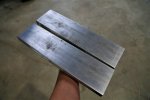- Joined
- Jan 21, 2020
- Messages
- 551
Steel has additional benefit. When quenched, all together can be put in an oven and go for bainite.When time comes I will use mild steel plates for stainless steel HT , anyway its purpose is only to keep steel straight

